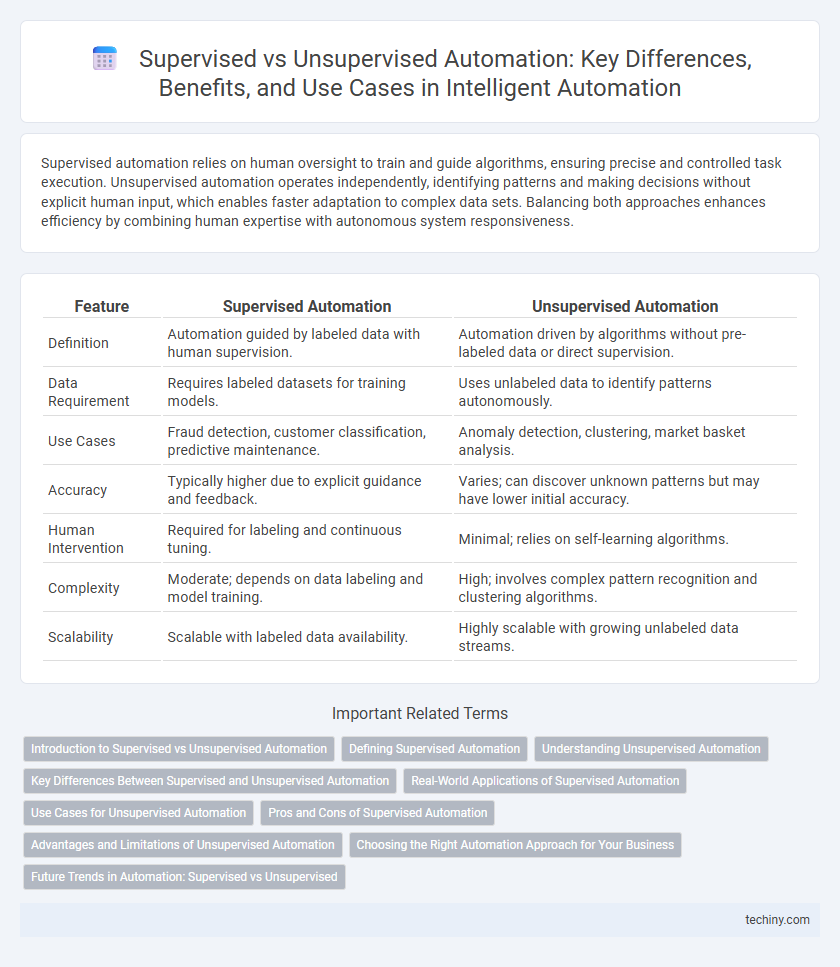Supervised automation relies on human oversight to train and guide algorithms, ensuring precise and controlled task execution. Unsupervised automation operates independently, identifying patterns and making decisions without explicit human input, which enables faster adaptation to complex data sets. Balancing both approaches enhances efficiency by combining human expertise with autonomous system responsiveness.
Table of Comparison
| Feature | Supervised Automation | Unsupervised Automation |
|---|---|---|
| Definition | Automation guided by labeled data with human supervision. | Automation driven by algorithms without pre-labeled data or direct supervision. |
| Data Requirement | Requires labeled datasets for training models. | Uses unlabeled data to identify patterns autonomously. |
| Use Cases | Fraud detection, customer classification, predictive maintenance. | Anomaly detection, clustering, market basket analysis. |
| Accuracy | Typically higher due to explicit guidance and feedback. | Varies; can discover unknown patterns but may have lower initial accuracy. |
| Human Intervention | Required for labeling and continuous tuning. | Minimal; relies on self-learning algorithms. |
| Complexity | Moderate; depends on data labeling and model training. | High; involves complex pattern recognition and clustering algorithms. |
| Scalability | Scalable with labeled data availability. | Highly scalable with growing unlabeled data streams. |
Introduction to Supervised vs Unsupervised Automation
Supervised automation relies on labeled data and predefined rules to train models, enabling precise task execution and predictable outcomes. Unsupervised automation processes unlabeled data, identifying patterns and insights without explicit instructions, which allows for more adaptive and exploratory applications. Both approaches enhance operational efficiency but differ in data requirements, learning methods, and applicability across industries.
Defining Supervised Automation
Supervised automation involves machine learning models trained on labeled datasets where input-output pairs guide decision-making processes. This method requires human intervention to label data and validate outcomes, ensuring higher accuracy and reliability in tasks like fraud detection or quality control. Supervised automation excels in environments where clear, structured data and defined objectives enable precise algorithmic predictions.
Understanding Unsupervised Automation
Unsupervised automation leverages machine learning algorithms to identify patterns and make decisions without human-labeled data, enabling systems to adapt autonomously in complex environments. Unlike supervised automation, which relies on predefined rules and annotated datasets, unsupervised models use techniques such as clustering and anomaly detection to uncover hidden insights from raw data. This approach enhances scalability and flexibility in automation processes, particularly in dynamic industries like cybersecurity and predictive maintenance.
Key Differences Between Supervised and Unsupervised Automation
Supervised automation relies on predefined rules and labeled datasets to guide processes, ensuring consistent and predictable outcomes, while unsupervised automation autonomously identifies patterns and insights from unlabeled data, allowing for adaptive and exploratory operations. Supervised systems require continuous human oversight and training to update algorithms, whereas unsupervised systems operate with minimal intervention, leveraging machine learning techniques like clustering and anomaly detection. The key differences lie in control mechanisms, data dependency, and flexibility--supervised automation excels in structured environments, whereas unsupervised automation thrives in dynamic, complex scenarios.
Real-World Applications of Supervised Automation
Supervised automation leverages labeled data to train models that make accurate predictions or decisions in industries such as finance for fraud detection, healthcare for medical diagnosis, and retail for personalized recommendations. These applications rely on historical data with known outcomes to continuously improve system performance and reliability. Real-world deployments of supervised automation enhance efficiency by automating complex tasks while maintaining high accuracy through ongoing human oversight and feedback.
Use Cases for Unsupervised Automation
Unsupervised automation excels in complex data analysis scenarios where predefined rules are impractical, such as anomaly detection in network security or customer segmentation in marketing. It enables systems to independently identify patterns and insights from large, unstructured data sets without human intervention. Industries leveraging unsupervised automation benefit from enhanced decision-making speed and accuracy in dynamic environments.
Pros and Cons of Supervised Automation
Supervised automation relies on labeled data and human intervention to train models, ensuring higher accuracy and predictability in task execution, especially in complex scenarios. It excels in environments where data quality and clear outcome expectations are critical, but its dependency on continuous human input and extensive labeled datasets can increase operational costs and limit scalability. The need for ongoing supervision makes supervised automation less adaptable to dynamic or unstructured data compared to unsupervised approaches.
Advantages and Limitations of Unsupervised Automation
Unsupervised automation excels in handling large-scale data without requiring labeled inputs, significantly reducing the need for human intervention and enabling faster adaptation to new patterns. Its main advantage lies in discovering hidden insights and anomalies in complex datasets, enhancing decision-making processes. However, limitations include challenges in accuracy and interpretability, as the system may generate ambiguous results without explicit guidance, necessitating occasional human oversight for validation.
Choosing the Right Automation Approach for Your Business
Supervised automation relies on labeled data and human input to train algorithms, making it ideal for tasks with clear rules and predictable outcomes, such as customer service chatbots or fraud detection systems. Unsupervised automation enables systems to identify patterns and insights without predefined labels, suitable for complex data analysis, anomaly detection, and personalized recommendations. Selecting the right approach depends on your business goals, data availability, and the need for human oversight versus autonomous decision-making.
Future Trends in Automation: Supervised vs Unsupervised
Future trends in automation highlight a significant shift towards integrating supervised and unsupervised automation systems to enhance adaptability and efficiency. Supervised automation relies on labeled datasets and human oversight to improve machine learning models, whereas unsupervised automation leverages pattern recognition and clustering algorithms to autonomously identify insights without predefined labels. Advances in AI, edge computing, and real-time data processing will drive the convergence of these approaches, enabling smarter, more flexible automation across industries.
Supervised Automation vs Unsupervised Automation Infographic

 techiny.com
techiny.com